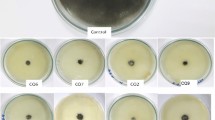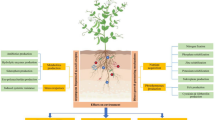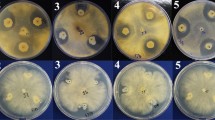Abstract
Beneficial interactions of plant growth-promoting rhizobacteria and arbuscular mycorrhizal fungi (AM Fungi) are vital to keep agriculture sustainable. The present study involves the isolation of Acinetobacter junii and the extraction of spores of Rhizophagus intraradices and R. fasciculatus from the rhizospheric region of Solanum lycopersicum and Capsicum annuum plants. Dual inoculation resulted in growth promotional aspects such as on the fruit yield (1.98 kg plant−1), increased biomass (30.36 g tomato; 10.67 g bell pepper), ≅93 % root colonization, phosphate accumulation in shoots (2.06 mg mL−1 tomato; 2.26 mg mL−1 bell pepper), number of spores (238 tomato, 242 bell pepper), and glomalin, a soil-related protein (16.75 mg mL−1 tomato; 18.09 mg mL−1 bell pepper) in both the plants.


Similar content being viewed by others
References
Ahemad M, Kibret M (2014) Mechanisms and applications of plant growth promoting rhizobacteria: current perspective. J King Saud Univ Sci 26:1–20
Azcόn R (1987) Germination and hyphal growth of Glomus mosseae in vitro: effects of rhizosphere bacteria and cell-free culture media. Soil Biol Biochem 119:417–419
Bhromsiri C (2009) Use of soil microbial inoculation for improving the effectiveness of vetiver grass and the effect on natural soil microbial ecology. Ph.D. Thesis Chiang Mai University
Boer WD, Larissa BF, Summerbell CR, Lynne B (2005) Living in a fungal world: impact of fungi on soil bacterial niche development. FEMS Microbiol Rev 29:795–811
Bolan NS (1991) A critical review of the role of mycorrhizal fungi in the uptake of phosphorus by plants. Plant Soil 134:189–207
Cappuccino JG, Sherman N (1992) Biochemical activities of microorganisms. Microbiology, A laboratory manual. The Benjamin Cummings Publishing Co., California
Castric PA (1975) Hydrogen cyanide, a secondary metabolite of Pseudomonas aeruginosa. Can J Microbiol 21:613–618
Didiek HG, Siswanto K, Yudho S (2000) Bioactivation of poorly soluble phosphate rocks with a phosphorus-solubilizing fungus. Soil Sci Am J 64:927–932
Fiske CH, Subbarow Y (1925) The colorimetric determination of phosphorus. J Biol Chem 66:375–400
Garg N, Chandel S (2010) Arbuscular mycorrhizal networks: process and functions: a review. Agron Sustain Dev 30:581–599
Gaur A, Adholeya V (1999) Mycorrhizal effects on the acclimatization, survival, growth and chlorophyll of micropropagated Syngonium and Dracaena inoculated at weaning and hardening stages. Mycorrhiza 9:215–219
Gerdemann JW, Nicolson YH (1963) Spores of mycorrhiza Endogone species extracted from soil by wet sieving and decanting. Trans Br Mycol Soc 46:235–244
Gordon SA, Weber RP (1951) Colorimetric estimation of indole acetic acid. Plant Physiol 26:192–195
Gupta RS, Rekha S, Aparna S, Kuhad RC (1994) A modified plate assay for screening phosphate solubilizing microorganisms. J Gen Appl Microbiol 40:255–260
Johnson LF, Curl AE (1972) Method for the research on ecology of soil borne plant pathogens. Burgess Publishing Company, Minneapolis
Kapoor KK, Misra MM, Kukreja K (1989) Phosphate solubilization by soil microorganisms: a review. Ind J Microbiol 29:119–127
Koide RT, Schreiner RP (1992) Regulation of the vesicular-arbuscular mycorrhizal symbiosis. Annu Rev Plant Physiol Plant Mol Biol 43:557–581
Kremer RJ (2006) Deleterious rhizobacteria. In: Gnanamanickam SS (ed) Plant-association bacteria. Springer, Netherlands, pp 335–357
Larkin MA, Blackshields G, Brown NP, Chenna R, McGettigan PA, McWilliam H, Valentin F, Wallace IM, Wilm A, Lopez R, Thompson JD, Gibson TJ, Higgins DG (2007) ClustalW and ClustalX version 2. Bioinformatics 23:2947–2948
Linderman RG (1997) Vesicular–arbuscular mycorrhizal (VAM) fungi. In: Caroll GC, Tudzynski P (eds) The Mycota. Springer-Verlag, Berlin, pp 117–128
Linderman RG, Davis EA (2004) Evaluation of commercial inorganic and organic fertilizer effect on arbuscular mycorrhizae formed by Rhizophagus intraradices. Hortic Technol 14:196–202
María DCJV, Ana SRR, Luis ABN (2006) Effect of the combined inoculation of arbuscular mycorrhizal fungi and plant- growth promoting rhizobacteria on papaya (Carica papaya L.) infected with the root-knot nematode Meloidogyne incognita. Fruits 61:1–7
Nehl DB, AllenSJ Brown JF (1996) Deleterious rhizosphere bacteria: an integrating perspective. Appl Soil Ecol 5:1–20
Olaniyi JO, Ajibola AT (2008) Effect of organic and inorganic fertilizers application on the growth, fruit yield and quality of tomato. J Appl Biosci 8:236–242
Padmavathi T, Ranjini R (2011) Effect of arbuscular mycorrhizal fungi on the growth of Ocimum sanctum and glomalin soil related protein. Res J Biotechnol 6:44–50
Phillips JM, Hayman DS (1970) Improved procedures for clearing roots and staining parasitic and vesicular-arbuscular mycorrhizal fungi for rapid assessment of infection. Trans Br Mycol Soc 55:157–160
Prasad K, Aggarwal AK, Yadav K, Tanwar A (2012) Impact of different levels of superphosphate using arbuscular mycorrhizal fungi and Pseudomonas fluorescens on Chrysanthemum indicum L. J Soil Sci Plant Nutr 12:451–462
Qiu-Dan N, Ying-Ning Z, Qiang-Sheng WU, Yong-Ming H (2013) Increased tolerance of citrus (Citrus tangerina) seedlings to soil water deficit after mycorrhizal inoculation: changes in antioxidant enzyme defense system. Not Bot Horti Agrobot 41:524–529
Ridge EH, Rovira AD (1971) Phosphatase activity of intact young wheat roots under sterile and nonsterile conditions. New phytol 70:1017–1026
Roger DF (2008) Ecological aspects of mycorrhizal symbiosis: with special emphasis on the functional diversity of interactions involving the extraradical mycelium. J Exp Bot 59:1115–1126
Sivasakthi S, Usharani G, Saranraj P (2014) Biocontrol potentiality of plant growth promoting bacteria (PGPR)-Pseudomonas fluorescens and Bacillus subtilis: a review. Afr J Agric Res 9:1265–1277
Sundara B, Natarajam V, Hari K (2002) Influence of phosphorus solubilizing bacteria on the changes on soil available phosphorus and sugarcane and sugar yields. Field Crop Res 77:43–49
Tanwar A, Aggarwal A, Karishma N (2012) Effectiveness of endomycorrhizal fungi and Pseudomonas fluorescens under different phosphorus levels on Capsicum annuum L. Kasetsart J (Nat Sci) 46:769–782
Tanwar A, Aggarwal A, Kadian N, Gupta A (2013) Arbuscular mycorrhizal inoculation and super phosphate application influence plant growth and yield of Capsicum annuum. J Soil Sci Plant Nutr 13:55–66
Tohidi M, Sani H B, Ghoshchi F (2004) The effects of nitrogen fixing and phosphate solubilizing bacteria on some quantitative parameters of soybean from sustainable agricultural point of views. In: Proceedings of 8th agronomy and plant breeding congress of Iran. Guilan University, Iran
Viswanathan G, Tholkappian P, Viswanathan K (2011) Influence of arbuscular mycorrhizal fungi and Azospirillum co-inoculation on the growth characteristics, nutritional content and yield of tomato crops grown in south India. Indian J Fundam Appl Life Sci 1:84–92
Acknowledgments
We thank the Department of Science and Technology of the Government of India, SERB, for financial support and Jain University, Bangalore, for providing the laboratory facilities.
Conflict of interest
The authors declare that there is no conflict of interest.
Author information
Authors and Affiliations
Corresponding author
Rights and permissions
About this article
Cite this article
Padmavathi, T., Dikshit, R. & Seshagiri, S. Effect of Rhizophagus spp. and plant growth-promoting Acinetobacter junii on Solanum lycopersicum and Capsicum annuum . Braz. J. Bot 38, 273–280 (2015). https://doi.org/10.1007/s40415-015-0144-z
Received:
Accepted:
Published:
Issue Date:
DOI: https://doi.org/10.1007/s40415-015-0144-z




